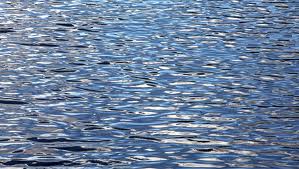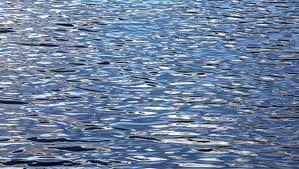 (This post appeared in my September 2012 Active Consciousness Newsletter).
(This post appeared in my September 2012 Active Consciousness Newsletter).
When water or the ocean appears in one’s dream, it is usually considered symbolic of the emotions or the unconscious mind. But if you think about it, our “every day” mind and emotions have a lot in common with a body of water too.
My husband Steve and I have just returned from our yearly summer vacation in Canada. While here, I usually sit for hours each day — resting, reading, meditating, or canoeing — looking at a body of water: the Moon River near Bala, Ontario. Although it is technically a river, the Moon is dammed downstream by a power generation plant, making it somewhat more like a meandering lake with many small bays. And because I spend so much time at the Moon’s edge, I also spend a lot of time contemplating the nature and behavior of water, especially its surface.
Imagine yourself looking at a medium-size lake before you. Just like our own minds, the great majority of the essence of a lake lies below its surface. The “real” lake is comprised of its inhabitants — the fish and flora that largely remain unseen unless we make the fairly strenuous effort required to suit up in scuba gear and explore it. Even so, much will remain unexplored and only vaguely understood. As a result, our usual focus and understanding of a lake pertains to its surface — the ripples and waves and other turbulence caused by factors that exists outside the lake: wind, boats, birds, dragonflies and other insects, and us humans splashing about. In fact, sometimes a wave can arrive at the shore that was generated quite a while ago by a passing boat.
And so it is with our minds. Our true selves are comprised of a vast universe that largely remains unseen unless we actively investigate below the surface. Our more typical conceptions of our “minds” and of our “selves” are merely surface features that are formed and pertain to things outside ourselves — our interactions with other people and things. These surface features are our every day thoughts and feelings — our reactions, the ripples on the surface. In fact, just like a wave that was generated by a distant boat, the things that shape this surface are often things that occurred in the distant past.
Just like a lake surface, our thoughts are rarely completely calm. Interestingly, the most calm times of day for a body of water (at least for our Moon River) are at dawn and at dusk. For some reason, the wind settles and human activity becomes quieter too. So too are our minds, which tend to be quieter when we are just waking and when we go to sleep. For this reason, these transitions into and out of sleep are also perfect times when we can more easily peer in and see beneath our surface. Just as I can see fish and reeds in the Moon at dawn and dusk, we can more easily catch a glimpse of our vast inner selves at transition points between wake and sleep.
If you look out at a lake, you will often see some areas that are calm and others that are ripply or turbulent. In fact, our eyes naturally gravitate toward the turbulent areas, just as we are naturally drawn to our most turbulent thoughts. It often takes more effort to appreciate the calm and to create it within ourselves.
Indeed, when things get too calm, most of us insist on splashing about! Too much calm makes most of us nervous. Quick! Turn on the TV! Start talking! Or how about eating something? Quiet can be unsettling. Distraction can be so much easier.
I see the same thing on the Moon. Just when the water becomes calm, everyone runs out for some boating and water fun. In fact, the more active one’s life tends to be, the more turbulent that fun must be. The old folk are satisfied with just sitting on the dock. The older adults get in their pontoon boats that glide about calmly and relatively noiselessly. The more contemplative types like me and my husband Steve get in our quiet canoes and paddle about. The teenagers and young adults create the most disturbance of all with their noisy sea-doos (an awful noise!), wakeboarding, tubing, and a motorboating style that tries to create the biggest possible wakes and turbulence. The little kids are satisfied with just jumping into the water and playing.
This graduated phenomenon of what’s “fun” or considered to be stimulating water activity has made me realize that it all depends on the amount of background noise in one’s life. The more busy and noisy our lives and our minds are, the more busy and noisy our distractions must be. With our fast-paced lives, constant movement, and non-stop bombardment by media and conversation, it takes a noisy sea-doo to get “out of our heads” and shut off the chatter of our surface minds. When our lives and minds are a bit quieter, a gliding pontoon boat or a canoe will do. When our minds are very young or our lives are more simple like a child’s or an elderly person’s, just feeling the water on our bodies or the gentle undulation of a dock is enough.
Back in the “old days”, when the world was less populated and our minds were less full of distraction, just having a guest over to one’s home for an evening of conversation was cause for much preparation and excitement. Playing piano and singing together in the parlor was every bit as stimulating as an iMax theater or a monster rave is today. It took a lot less. And it took a lot less of our Earth’s resources too.
As we move into the Fall and a new school year — often one of our busiest and most active times of year — let’s contemplate the lessons of water. To be happy with less, try to become more quiet inside. Focus more on the calm spots and try to delve below the surface of the mind. The quieter you become, the more you will appreciate the simple pleasures of the Earth, use less of its resources, and enjoy simply being with your selves and the ones you love.




0 Comments